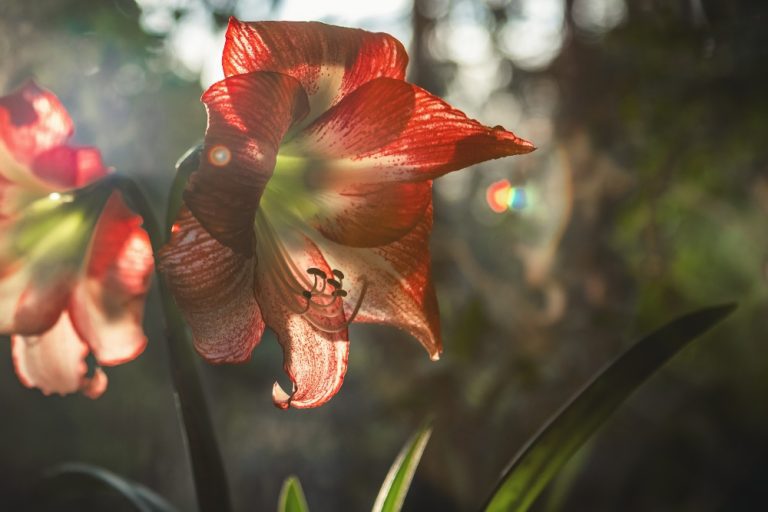When you purchase through links on our site, we may earn an affiliate commission. Here’s how it works.
Amaryllis plants are loved for their large, vibrant flowers. Ranging in color from white to dark red or burgundy, amaryllis bulbs are a popular choice for outdoor warm climate gardens, or those wishing to grow the bulb indoors for forcing during the winter season. Coming in various sizes, these large bulbs can be potted into containers and grown near a sunny window. Their ease of care makes them a popular gift for both experienced and amateur garden enthusiasts.
Amaryllis bulbs, specifically those sold for forcing during the winter, require certain conditions for adequate growth and the production of large flowers. From planting to bloom, there are several factors which may impact the overall health of the plant. Like many potted plants, diseases and issues related to fungal infections can be detrimental to the development of the plant and may even cause it to die before it is able to bloom. Amaryllis bulb rot is one such issue.
Amaryllis plants are a beloved holiday tradition for many gardeners Their gorgeous, trumpet-shaped blooms add a festive pop of color during the winter months However, these bulbs can fall victim to rot quite easily if proper care isn’t taken. Learning what causes rot in amaryllis and how to prevent it will help you enjoy these plants for many seasons to come.
What Causes Rot in Amaryllis?
Rot in amaryllis plants is most often caused by one of three factors
Overwatering – Amaryllis bulbs planted in dense, soggy soil are very prone to root and bulb rot. Their fleshy roots need a lighter, airier growing medium. Too much moisture around the bulb leads to fungal and bacterial rots.
Poor Drainage – Even if you’re careful not to overwater, poor drainage can still lead to excess moisture around the bulb. Make sure any pot you plant amaryllis in has adequate drainage holes. Heavy, dense potting mixes that retain moisture can also cause problems.
Disease – Fungal and bacterial diseases like red blotch, southern blight, and soft rot can infect amaryllis bulbs. Infection happens more readily when bulbs sit in wet conditions. Inspect bulbs carefully before planting and discard any that show signs of rot or disease.
Preventing Rot Starts at Planting Time
You can stave off many rot issues by taking a few preventative steps when first planting your amaryllis bulbs:
-
Start with healthy bulbs – Carefully inspect bulbs before purchase or planting. Avoid any with soft, damaged, or discolored areas which may indicate disease.
-
Use a well-draining soil mix – Choose a commercial potting mix made for bulbs and combine with perlite or gravel to improve drainage.
-
Allow excess moisture to drain – Plant bulbs in containers with drainage holes. Elevate pots above saucers so they don’t sit in water.
-
Water sparingly – Until growth emerges, water new bulbs just once and then allow the soil to dry out before watering again.
Stopping Rot in Its Tracks
If you notice signs of rot in your amaryllis plant, prompt action is needed to stop it from spreading:
-
Remove affected bulbs or roots – Clip off any mushy, discolored or foul-smelling tissue with sterilized shears. Removing diseased parts prevents them from infecting the rest of the plant.
-
Apply a fungicide – Treating remaining healthy tissue with a fungicidal spray or powder prevents infection. Follow label directions carefully.
-
Repot in fresh, sterile soil – Gently wash off roots and replant in new, well-draining soil to fully eliminate diseased material.
Water Wisely – Adjusting Your Watering Habits Soggy soil is a no-go; it’s the fast track to root rot. To strike the right balance, check the top inch of soil—dry? It’s time to water. Overwatering symptoms include limp leaves and a sense of the plant’s spirit being waterlogged.
Keep Those Blooms Coming
With extra care taken at planting time and quick action if disease appears, your amaryllis bulbs should keep delivering beautiful winter flowers year after year. Just be sure to store bulbs properly in a cool, dry spot during their summer dormancy. Then bring them out in late fall, and you’ll soon enjoy a holiday filled with cheerful blossoms.

Why are My Amaryllis Bulbs Rotting?
There are several reasons why amaryllis bulbs may begin to rot. Among these causes is fungal infection. In many cases, spores are able to enter through the outer scales of the amaryllis bulb and then continue the rotting process from within. Though minor infections may not impact the bloom of the plant, those that are more severe can cause the eventual collapse of the amaryllis plant.
While fungal infections are very common in these bulbs, other rot issues may stem from moisture or exposure to extreme temperatures. Bulbs that have been planted into containers or garden beds which fail to drain adequately can be a definitive cause of rotten amaryllis bulbs. This is especially true of amaryllis varieties that are slow to sprout roots and begin the growth process.
In addition to these factors, amaryllis bulb rot may occur when the bulbs have been damaged by extremely cold temperatures during storage or throughout the shipping process. In general, it is best to discard rotting amaryllis bulbs. This will help to prevent the spread of fungal infection to other plants.
How to Save a Rotten Amaryllis (Hippeastrum) Bulb
FAQ
What causes amaryllis bulb rot?
Are coffee grounds good for amaryllis?
